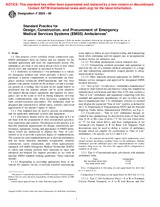Wir benötigen Ihre Einwilligung zur Verwendung der einzelnen Daten, damit Sie unter anderem Informationen zu Ihren Interessen einsehen können. Klicken Sie auf "OK", um Ihre Zustimmung zu erteilen.
ASTM F2020-00
Standard Practice for Design, Construction, and Procurement of Emergency Medical Services Systems (EMSS) Ambulances
Automatische name übersetzung:
Standard Praxis für die Auslegung, den Bau und die Beschaffung von Emergency Medical Services Systems ( EMSS ) Krankenwagen
NORM herausgegeben am 10.2.2002
Informationen über die Norm:
Bezeichnung normen: ASTM F2020-00
Anmerkung: UNGÜLTIG
Ausgabedatum normen: 10.2.2002
SKU: NS-52467
Zahl der Seiten: 44
Gewicht ca.: 132 g (0.29 Pfund)
Land: Amerikanische technische Norm
Kategorie: Technische Normen ASTM
Die Annotation des Normtextes ASTM F2020-00 :
Keywords:
ambulance, emergency, medical, EMS, ambulance, star of life, EMSS, transport, ICS Number Code 43.160 (Special purpose vehicles)
Ergänzende Informationen
| 1. Scope | |||||||||||||||||||||||||||||||||||
|
1.1 This practice covers certified, tested, commercial type, EMSS ambulances built on chassis that are suitable for the intended application and meet the requirements herein. The ambulances are front or rear wheel driven (4x2) or four wheel driven (4x4) and warranted as specified in Section 9. 1.1.1 Definition of Ambulance—An ambulance is a vehicle for emergency medical care which provides: a driver's compartment; a patient compartment to accommodate an emergency medical technician (EMT)/paramedic and two litter patients (one patient located on the primary cot and a secondary patient on a folding litter located on the squad bench) so positioned that the primary patient can be given intensive life-support during transit; equipment and supplies for emergency care at the scene as well as during transport; two-way radio communication; and, when necessary, equipment for light rescue/extrication procedures. The ambulance shall be designed and constructed to afford safety, comfort, and avoid aggravation of the patient's injury or illness. 1.1.2 This standard may be used to procure an ambulance and the applicable additional systems and equipment. 1.1.3 Purchasers should follow the ordering data in 9.2 to aid them with the preparation of their procurement specification, requisition, and contract. The purpose of this practice is to describe minimum requirements for design, construction, performance, equipment, testing, and appearance of EMSS ambulances which are authorized to display the "Star of Life" symbol so as to provide a practical degree of standardization. The reasons for such standardization are to provide ambulances that are easily detected, nationally recognizable, properly constructed, easily maintained, and, when appropriately equipped, will enable Emergency Medical Technicians (EMTs) to safely and reliably perform their functions as basic and advanced pre-hospital life support providers as set forth in national EMSS standard training guidelines. These functions include: 1.1.3.1 Responding to, providing appropriate basic or advanced life support, on-site, to persons reported experiencing acute injury or illness in a pre-hospital setting, and transporting them, while continuing such life support care, to an appropriate medical facility for definitive care. 1.1.3.2 Providing interhospital critical transport care. 1.1.3.3 Transporting essential personnel and equipment to and from the site of a multiple medical emergency or a triage site and transporting appropriately triaged patients to designated medical facilities. 1.1.3.4 Other functions deemed appropriate by EMSS ambulance service managers and approved by designated EMSS medical directors. 1.2 "Star of Life" Certification—Ambulance manufacturer/contractor shall furnish the purchaser(s) citing this standard an authenticated certification and label (see 6.19) that certifies a "Star of Life" ambulance and equipment complying with this standard and applicable amendments (if any) in effect on the date of manufacture (see 7.3). Ambulance vehicles so certified may display the registered "Star of Life" symbol, as defined by the U.S. Department of Transportation (DOT) and the National Highway Traffic Safety Administration (NHTSA), see Fig 1. 1.3 Classification— "Star of Life" ambulance designs included in this standard may be described in terms of their body type (I, II, or III), class of drive ("1" for two rear wheel drive or "2" for four wheel drive), and floor configuration (A for Advanced Life Support or B for Basic Life Support). Such descriptions may be used to define a variety of ambulance designs which are eligible for certification as "Star of Life" ambulances. (To specify, see 9.2.2 and 9.2.3). Note 1—For optional advanced life support (ALS) applications, users should consider specifying a modular (Type I or III) ambulance. Modular ambulances provide additional space and compartmentation for cardiac monitors, drug cases, and so forth. The basic life support (BLS) configuration is standard on all types. 1.3.1 Type I—Conventional truck, cab-chassis with modular ambulance body (see Fig. 2).
Configuration A: Elevating cot and squad
bench for ALS (See 6.1.5.1 and 6.11.4). Type I—AD (Additional Duty—with increased GVWR, storage, and payload capacity)—)A or B or Neonatal, Critical Patient Transport, or A or B with Rescue and Fire Suppression Package or a combination thereof. (See 6.1.2.1)
* As specified by purchaser. The configuration shall provide for a neonatal, critical patient transport, configuration A or B with fire suppression package and rescue capability when specified. 1.3.2 Type II—Standard van, integral cab-body ambulance (See 6.1.3 and Fig 3.)
**On a Type II, ALS features
are limited, (see 9.2.3) 1.3.3 Type III—Cutaway van, cab-chassis with integral or containerized modular body ambulance (see 6.1.4 and Fig 4).
1.3.3.1 Type III— AD (Additional Duty-with increased GVWR, storage, and payload capacity) A or B or neonatal, critical patient transport, or A or B with rescue, or fire suppression package, or both (see 6.1.4.1).
*As specified by purchaser. The configuration shall provide for a neonatal, critical patient transport, configuration A or B with fire suppression package and rescue capability when specified. 1.4 Order of Precedence—In the event of a conflict between the text of this practice and the references cited herein, the text of this practice shall take precedence, except where required by law including Federal, State, and local laws and regulations. 1.5 This standard does not purport to address all of the safety concerns, if any, associated with its use. It is the responsibility of the user of this standard to establish appropriate safety and health practices and determine the applicability of regulatory limitations prior to use. |
|||||||||||||||||||||||||||||||||||
| 2. Referenced Documents | |||||||||||||||||||||||||||||||||||
|
Empfehlungen:
Aktualisierung der technischen Normen
Wollen Sie sich sicher sein, dass Sie nur die gültigen technischen Normen verwenden?
Wir bieten Ihnen eine Lösung, die Ihnen eine Monatsübersicht über die Aktualität der von Ihnen angewandten Normen sicher stellt.
Brauchen Sie mehr Informationen? Sehen Sie sich diese Seite an.




 Cookies
Cookies
